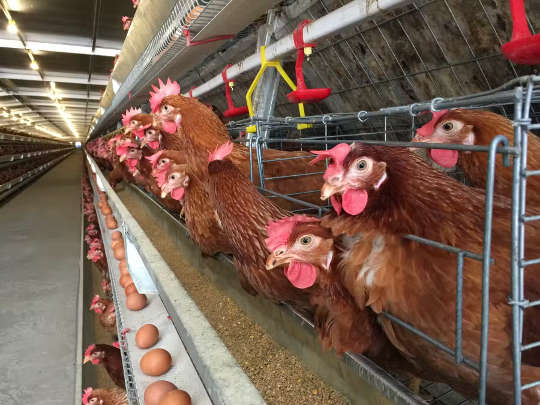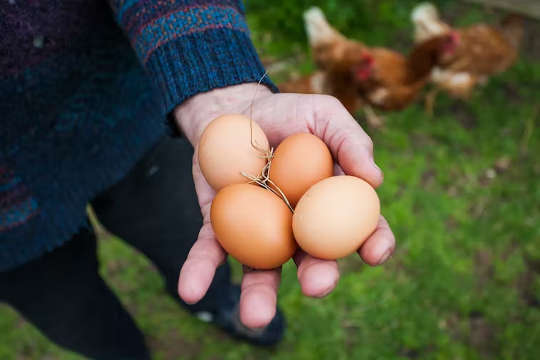The UK is in the grip of its largest ever outbreak of bird flu. As its name suggests, avian influenza primarily affects birds, but it can also infect humans and other mammals. The virus first emerged in China in 1996 and the highly pathogenic H5N1 is the predominant variant causing havoc at the moment.
The cramped housing and unrestricted transportation of farmed birds has allowed H5N1 to spread rapidly, leaving devastation in its wake. It is not just poultry that is affected. The current outbreak is killing wildlife on an unprecedented scale, from seabirds in the UK to sea lions in Peru.
Though the UK government currently assesses the risk to the wider public as very low, some strains of bird flu can pass to humans after sustained close contact. The producers of David Attenborough’s latest television series had to pull plans for him to film close to seabirds on the island of Skomer for fears he might catch the disease.
As a result of the outbreak, mandatory housing of chickens has been in place in England since November 2022. This means that no eggs produced in England are currently “free-range”. There is no defined end to this situation and as of February, all free-range eggs have been relabelled.
Some customers are unhappy with buying eggs from chickens without access to the outdoors. But exploring the history of free-range eggs in the UK reveals why their preferred purchases may never have been that safe or ethical in the first place.
The fall and rise of free-range
The RSPCA defines free-range eggs as those coming “from birds that, during the daytime, enjoy unlimited access to outdoor pastures”. Before the mid-20th century, almost all eggs in the UK were free-range. Aside from some semi-intensive systems, where chickens were kept permanently in sheds, there were no alternatives.
The mass adoption of battery cages from the 1950s onwards transformed the egg industry. Battery farming sees hens packed into cages to control their environment and increase the number of eggs they lay. In the UK, free-range eggs accounted for 80% of all eggs produced in 1951. By 1980, the figure was 1%.
The welfare of chickens kept in battery farms naturally suffered. Ruth Harrison’s 1964 book Animal Machines was among the first to reveal the cruelty of modern poultry production.
In it, she described the “miserable and debilitated” life of battery hens. This became a focal point of activism and sparked a government investigation into farm animal welfare just a year later.
But it was not until a panic over the alleged presence of salmonella in eggs in 1988 that public opinion began to change. Thanks to that and other scares, such as the outbreak of “mad cow” disease on beef farms in the 1990s, the public perception of intensively farmed food shifted from safe to risky.

Hens raised in battery cages are unable to express their natural behaviour. Mai.Chayakorn/Shutterstock
Alternative systems for producing eggs became more popular as a result. From their 1981 nadir, free-range eggs now constitute over 60% of the 11.3 billion eggs produced in the UK annually, according to a 2021 industry estimate.
Safe and ethical?
Free-range eggs are perceived as safer by consumers and an easier ethical choice. Supermarkets offer an abundance of free-range products and there is no great difference in price compared with eggs from caged hens.
However, free-range egg farms differ from the advertised scenes of chickens roaming free in open fields. In fact, free-range flocks can reach up to 16,000 hens a shed, with daytime access to the outside provided by holes in the perimeter.
Beaks are trimmed to prevent the fighting that arises as a result of stress in this unnatural environment. More expensive organic eggs, produced by much smaller flocks on farms where beak trimming is banned, are a minority of those eaten in the UK.
Free-range egg farming is seen as both safer and more ethical than other forms of production. Though free from the worst excesses of battery farming, eggs with the free-range label are still produced on densely packed farms. Large, intensive systems such as these are implicated in the spread of bird flu, devastating poultry and wildlife alike.
Along with salad shortages and “milkflation”, the disappearance of free-range eggs from English supermarkets is symptomatic of a food system responding to environmental stresses. The risks to animal welfare and the environment inherent in this system will remain without more radical changes to the scale and density of animal agriculture.
About the Author
Joel Mead, PhD Candidate in History, University of Liverpool
This article is republished from The Conversation under a Creative Commons license. Read the original article.
Nutrition books on from Amazon's Best Sellers list
"The Blue Zones Kitchen: 100 Recipes to Live to 100"
by Dan Buettner
In this book, author Dan Buettner shares recipes from the world's "Blue Zones," regions where people live the longest and healthiest lives. The recipes are based on whole, unprocessed foods and emphasize vegetables, legumes, and whole grains. The book also includes tips for following a plant-based diet and living a healthy lifestyle.
Click for more info or to order
"Medical Medium Cleanse to Heal: Healing Plans for Sufferers of Anxiety, Depression, Acne, Eczema, Lyme, Gut Problems, Brain Fog, Weight Issues, Migraines, Bloating, Vertigo, Psoriasis, Cys"
by Anthony William
In this book, author Anthony William offers a comprehensive guide to cleansing and healing the body through nutrition. He provides evidence-based recommendations for foods to include and avoid, as well as meal plans and recipes to support the cleanse. The book also includes information on how to address specific health concerns through nutrition.
Click for more info or to order
"The Forks Over Knives Plan: How to Transition to the Life-Saving, Whole-Food, Plant-Based Diet"
by Alona Pulde and Matthew Lederman
In this book, authors Alona Pulde and Matthew Lederman offer a step-by-step guide to transitioning to a whole-food, plant-based diet. They provide evidence-based recommendations for nutrition, along with practical advice for shopping, meal planning, and preparation. The book also includes recipes and meal plans to support the transition.
Click for more info or to order
"The Plant Paradox: The Hidden Dangers in 'Healthy' Foods That Cause Disease and Weight Gain"
by Dr. Steven R. Gundry
In this book, Dr. Steven R. Gundry provides a controversial perspective on nutrition, arguing that many so-called "healthy" foods can actually be harmful to the body. He provides evidence-based recommendations for optimizing nutrition and avoiding these hidden dangers. The book also includes recipes and meal plans to help readers implement the Plant Paradox program.
Click for more info or to order
"The Whole30: The 30-Day Guide to Total Health and Food Freedom"
by Melissa Hartwig Urban and Dallas Hartwig
In this book, authors Melissa Hartwig Urban and Dallas Hartwig offer a comprehensive guide to the Whole30 program, a 30-day nutrition plan designed to promote health and wellness. The book provides information on the science behind the program, as well as practical advice for shopping, meal planning, and preparation. The book also includes recipes and meal plans to support the program.























